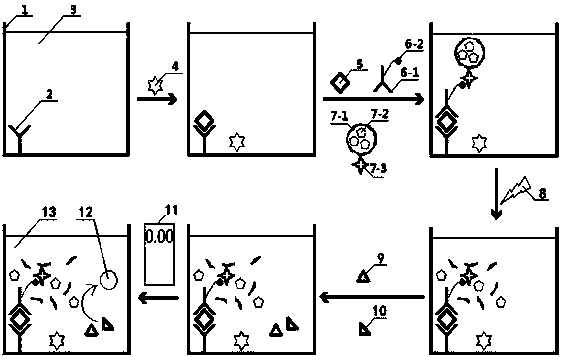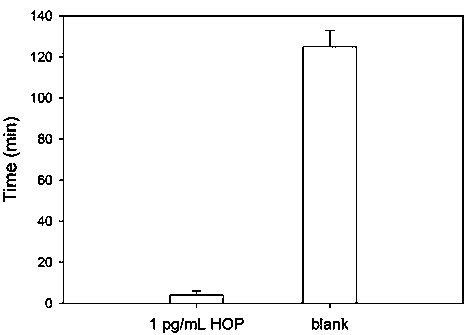Instrument-free enzyme-linked immunosorbent assay method
A technology of enzyme-linked immunosorbent assay and determination method, which is applied in the field of instrument-free enzyme-linked immunosorbent assay, can solve the problems of inability to use on-site analysis and instant detection, high analysis cost, and high price, so as to reduce analysis cost and broad application prospects , The effect of improving the detection sensitivity
- Summary
- Abstract
- Description
- Claims
- Application Information
AI Technical Summary
Problems solved by technology
Method used
Image
Examples
Embodiment 1
[0022] Use the instrument-free enzyme-linked immunosorbent assay method of the present invention to detect 1 pg / mL HOP antigen and blank samples (blank, buffer solution without analyte). Such as figure 1 Shown, the specific steps of this embodiment are:
[0023] Step 1: Add 100 μL of 0.2 mg / mL HOP antibody (prepared in 12 mM sodium bicarbonate-sodium carbonate buffer solution, pH 9.5) to one well on a 96-well plate, and let stand overnight at 4°C in the refrigerator. Discard the liquid and shake dry. Fill each well with washing solution (10 mM sodium dihydrogen phosphate-dipotassium hydrogen phosphate buffer solution, pH 7.2), let it stand for 40 s, and then discard it. After repeating this 5 times, put the well upside down on the flattened roll paper Pat dry.
[0024] Step 2: Add 100 μL of 15 mg / mL bovine serum albumin (BSA) (prepared in 12 mM sodium bicarbonate-sodium carbonate buffer solution, pH 9.5) to a single well and let stand at room temperature for 5 h. Discard t...
Embodiment 2
[0031] The HOP antigen with a concentration range of 0.1 fg / mL to 100 pg / mL is detected by using the instrument-free ELISA method of the present invention. Such as figure 1 Shown, the specific steps of this embodiment are:
[0032]Step 1: Add 100 μL of 0.2 mg / mL HOP antibody (prepared in 12 mM sodium bicarbonate-sodium carbonate buffer solution, pH 9.5) to one well on a 96-well plate, and let stand overnight at 4°C in the refrigerator. Discard the liquid and shake dry. Fill each well with washing solution (10 mM sodium dihydrogen phosphate-dipotassium hydrogen phosphate buffer solution, pH 7.2), let it stand for 40 s, and then discard it. After repeating this 5 times, put the well upside down on the flattened roll paper Pat dry.
[0033] Step 2: Add 100 μL of 15 mg / mL bovine serum albumin (BSA) (prepared in 12 mM sodium bicarbonate-sodium carbonate buffer solution, pH 9.5) to a single well and let stand at room temperature for 5 h. Discard the liquid and shake dry. Then f...
PUM
| Property | Measurement | Unit |
|---|---|---|
| particle diameter | aaaaa | aaaaa |
| particle diameter | aaaaa | aaaaa |
Abstract
Description
Claims
Application Information
 Login to View More
Login to View More - R&D
- Intellectual Property
- Life Sciences
- Materials
- Tech Scout
- Unparalleled Data Quality
- Higher Quality Content
- 60% Fewer Hallucinations
Browse by: Latest US Patents, China's latest patents, Technical Efficacy Thesaurus, Application Domain, Technology Topic, Popular Technical Reports.
© 2025 PatSnap. All rights reserved.Legal|Privacy policy|Modern Slavery Act Transparency Statement|Sitemap|About US| Contact US: help@patsnap.com



